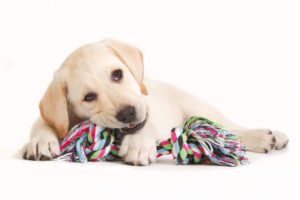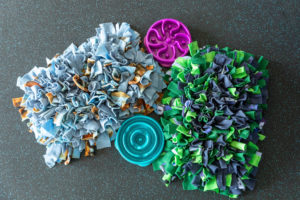
Puppies are hard. They require constant supervision. They have needle-sharp teeth and think it’s great fun to chew on your hands or clothes. They pee and poo and chew and jump and bite and bark and eat inappropriate/unsafe things. It is normal to feel frustration when raising a puppy. It is normal to need a break, even when you are simultaneously in love with your new bundle of furry joy. Puppies are hard. 
Many people who contact me for training help feel overwhelmed and frustrated, and they want to know how to make all of the “bad” behaviors STOP. And it’s true that a large part of good training involves changing the environment and your puppy’s access to it in ways that stop them from practicing undesirable behaviors, while we teach them desirable behaviors instead. We gate off rooms that aren’t puppy-proofed. We crate them to prevent potty accidents in the house or to help them settle down. We close closet doors to prevent shoes from falling prey to shark-mouthed puppies. We call this “management,” and it’s a valuable tool. However, I’ve come to realize that the usual ways we talk about management aren’t actually serving my true goal as a dog trainer and behavior consultant: building a better relationship between you and your puppy.
You see, our traditional view of management is all about stopping or preventing behaviors. It’s about control, and it’s about taking things away from your dog: certain activities or objects or spaces. I’d like to shift perspective for a moment, and expand our view to include the puppy’s needs, not just our own. Bear with me, because I think this will make your life with your puppy not only better, but easier.
 The behavior of puppies doesn’t happen in a vacuum, for no reason. Behaviors — chewing, mouthing, barking, peeing, etc — are trying to meet a need and serve a function. If we simply try to stop behaviors, without meeting the need that drives them, we are playing a game of whack-a-mole. Don’t get me wrong — I absolutely close my closet doors so that my shoes don’t become chew toys! But more importantly, I create an environment full of appropriate things for puppies to chew on, and an environment and schedule that meet a puppy’s needs, so they never go looking for my shoes in the first place.
The behavior of puppies doesn’t happen in a vacuum, for no reason. Behaviors — chewing, mouthing, barking, peeing, etc — are trying to meet a need and serve a function. If we simply try to stop behaviors, without meeting the need that drives them, we are playing a game of whack-a-mole. Don’t get me wrong — I absolutely close my closet doors so that my shoes don’t become chew toys! But more importantly, I create an environment full of appropriate things for puppies to chew on, and an environment and schedule that meet a puppy’s needs, so they never go looking for my shoes in the first place.
This perspective shift also gives me more patience and understanding: it may feel like my arm is a chew toy, but really that puppy is teething and needs to mouth and chew, and hands/arms are accessible and interesting, and move in fun ways (well, fun for the puppy!) when chewed on. If I know that mouthing/biting is a need, I can see my way clear to meeting the need with something else. It’s not enough to remove my hands. I need to provide multiple alternative choices for the puppy that meet the same need in a different way.

The old saying “an ounce of prevention is worth a pound of cure” applies to managing puppy behavior. Don’t leave your puppy guessing what to do to get what they want and need. Anticipate and attend to your puppy’s very normal needs (e.g. potty, food, water, enrichment, sleep, play, affection, sniffing, movement, etc) before your puppy gets into trouble. Walk them and then give them a food puzzle toy to work on before you need to get on that conference call or help your child with their homework, and you won’t be stuck trying to get them to stop interrupting your other activity. Provide appealing choices of things to chew on and make those toys more readily accessible than your shoes or the coffee table legs.

a teething puppy chewing on an appropriate object
This proactive approach avoids the frustrating cycle of reacting to and trying to stop behaviors we don’t want. It sets your puppy up for success, and it avoids a lot of frustration for both you and your puppy. By focusing on what need the puppy’s behavior is trying to meet, it’s easier to identify how to channel that behavior into a more human-compatible manifestation. Trying to understand and meet a puppy’s needs will help build trust and a better relationship.
Stay tuned for a series of posts illustrating what this looks like in practice in everyday life for specific behaviors and needs, and some helpful tools to use such as snuffle mats and food puzzle toys.

